Difference between revisions of "ACTA/Ventilation"
m (moved Space/Ventilation to ACTA/Ventilation) |
m |
||
| (22 intermediate revisions by 2 users not shown) | |||
| Line 1: | Line 1: | ||
{{Project | {{Project | ||
| − | |ProjectStatus= | + | |picture=Air-infra.jpg |
| + | |ProjectStatus=Finished | ||
|ProjectNiche=Mechanics | |ProjectNiche=Mechanics | ||
|ProjectPurpose=Infrastructure | |ProjectPurpose=Infrastructure | ||
}} | }} | ||
| − | + | == Introduction == | |
| + | |||
| + | With a heavy industrial fan kindly donated by Urban Resort/ACTA, a generous amount of my time+effort and a heap of community money and patience, we have now installed and operational(*) a hefty, powerful, versatile ventilation- or air suction system. | ||
| + | |||
| + | == Layout == | ||
| + | |||
| + | It encompasses six inlets in our space: {two in soldering area, one over general workbench, three in dirty room} and two future projected ones: one or more in clean room and one over kitchen area. The general idea is to block/close inlets when not in use, thereby not losing suction power. The smaller kitchen inlet will be open all the time, however. | ||
| + | |||
| + | == Powered by == | ||
| + | |||
| + | At the heart of the system is a large industrial fan powered by a ~300watt motor, which for reasons of noise suppression we built inside a padded wooden box which is suspended isolated with rubber rings to the ceiling in the dirty room. Still, the fan is audible/noisy, especially when cold (first 10-30 minutes). Lack of lubrication mostly. We're still looking into that; we know we need a special grease, '''Shell Alvania grease, lithium-based'''. We cannot, however, see where to insert that, unless we're prepared to take the motor/fan assembly '''''completely''''' apart. | ||
| + | |||
| + | == Future enhancements projected == | ||
| + | |||
| + | As a future project enhancement, we'd like to automate and protect the system further by it having a temperature readout, cut-off overheat protection, and a timer switch. For this purpose a temperature probe+module has been purchased already, and the probe installed on the fan engine. The rest however, needs to be designed and built. We already have a solid state relay for it. | ||
| + | |||
| + | == Pictures or it didn't happen == | ||
| + | |||
| + | Some pictures I took of the building stages and the finished inlets and how they ought to be blocked by the red plastic plugs. <br><br> | ||
| + | |||
| + | [[File:fanincasing.jpg|360px]] <br> | ||
| + | The large fan as it is meant to get mounted in its case. The entire thing hanging from ceiling by rubber-insulated bolts <br> | ||
| + | |||
| + | [[File:fanonceiling.jpg|600px]] <br> | ||
| + | The fan installed in its final position above the ceiling, with 160mm outlet hose connected. <br> | ||
| + | |||
| + | [[File:dirtyroom-inlets.jpg|480px]] <br> | ||
| + | The three inlets in the dirty room, two of them closed by red plugs, third one connected by flexible hose. Suction has proven strong enough to suck up sawdust, grit, etc. <br> | ||
| + | |||
| + | [[File:inlets-detail.jpg|480px]] <br> | ||
| + | The hose tube fits snugly in the ceiling plug; so there is no holding mechanism to defeat gravity; it holds there without help. Gently pulling the plug while turning/wiggling will release it. <br> | ||
| + | |||
| + | [[File:inlet-closeup.jpg|480px]] <br> | ||
| + | Detail view of the business end of a flex hose. Note that the same red plug, reversed, fits the hose. How to hold/place/connect to or above project, engine or tool is left as an exercise for the reader. <br> | ||
| + | |||
| + | [[File:airdistributionbox.jpg|600px]] <br> | ||
| + | What hackerish uglyness^Wepicness actually hides above those ceiling tiles in some spots. <br> | ||
| + | |||
| + | [[File:poweron.jpg|360px]] <br> | ||
| + | Pending a neater system, this big yellow switch is what turns it on and off now.<br> | ||
| + | |||
| + | |||
| + | |||
| + | |||
| + | (*) It is fully operational. However, what it lacks at this point is the timer + overheat electronics, the kitchen inlet, the clean room inlet. These in no way inhibit its use. | ||
| + | |||
| + | |||
| + | [[Category:ACTA]] | ||
Latest revision as of 23:47, 15 March 2013
| Projects | |
|---|---|
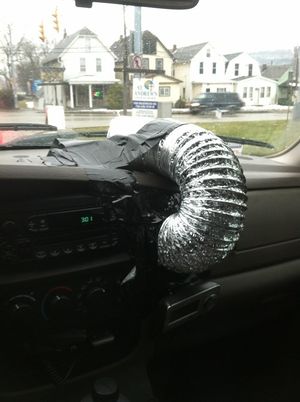
| |
| Participants | Ultratux |
| Skills | |
| Status | Finished |
| Niche | Mechanics |
| Purpose | Infrastructure |
Contents
Introduction
With a heavy industrial fan kindly donated by Urban Resort/ACTA, a generous amount of my time+effort and a heap of community money and patience, we have now installed and operational(*) a hefty, powerful, versatile ventilation- or air suction system.
Layout
It encompasses six inlets in our space: {two in soldering area, one over general workbench, three in dirty room} and two future projected ones: one or more in clean room and one over kitchen area. The general idea is to block/close inlets when not in use, thereby not losing suction power. The smaller kitchen inlet will be open all the time, however.
Powered by
At the heart of the system is a large industrial fan powered by a ~300watt motor, which for reasons of noise suppression we built inside a padded wooden box which is suspended isolated with rubber rings to the ceiling in the dirty room. Still, the fan is audible/noisy, especially when cold (first 10-30 minutes). Lack of lubrication mostly. We're still looking into that; we know we need a special grease, Shell Alvania grease, lithium-based. We cannot, however, see where to insert that, unless we're prepared to take the motor/fan assembly completely apart.
Future enhancements projected
As a future project enhancement, we'd like to automate and protect the system further by it having a temperature readout, cut-off overheat protection, and a timer switch. For this purpose a temperature probe+module has been purchased already, and the probe installed on the fan engine. The rest however, needs to be designed and built. We already have a solid state relay for it.
Pictures or it didn't happen
Some pictures I took of the building stages and the finished inlets and how they ought to be blocked by the red plastic plugs.
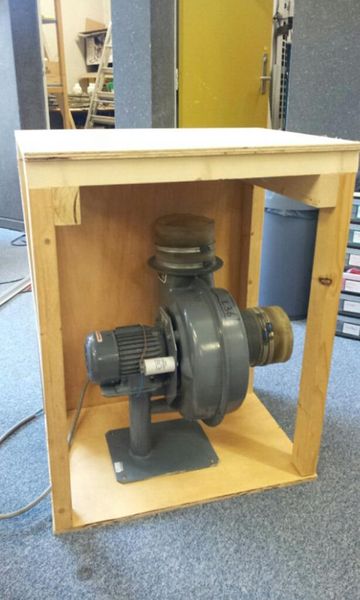
The large fan as it is meant to get mounted in its case. The entire thing hanging from ceiling by rubber-insulated bolts
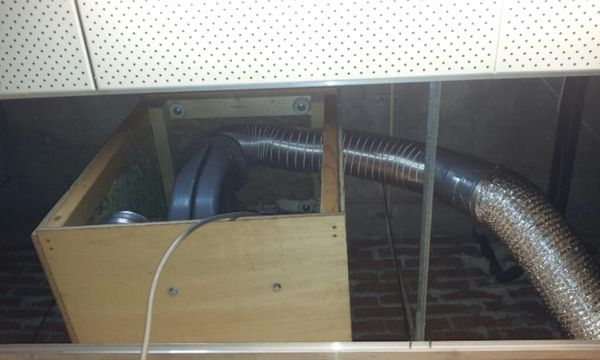
The fan installed in its final position above the ceiling, with 160mm outlet hose connected.
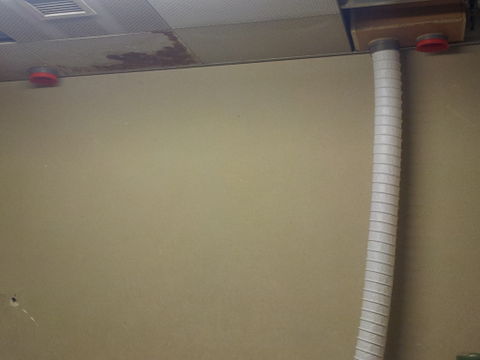
The three inlets in the dirty room, two of them closed by red plugs, third one connected by flexible hose. Suction has proven strong enough to suck up sawdust, grit, etc.
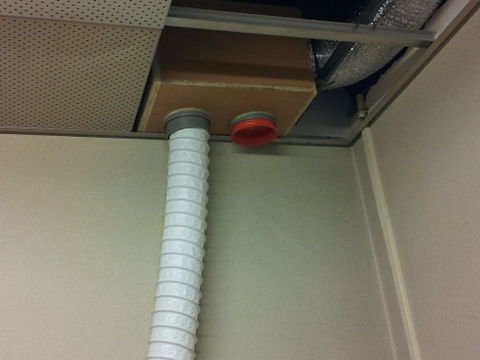
The hose tube fits snugly in the ceiling plug; so there is no holding mechanism to defeat gravity; it holds there without help. Gently pulling the plug while turning/wiggling will release it.
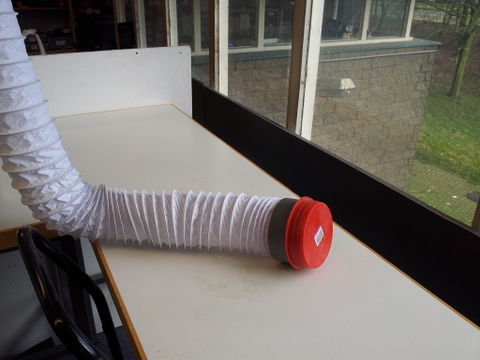
Detail view of the business end of a flex hose. Note that the same red plug, reversed, fits the hose. How to hold/place/connect to or above project, engine or tool is left as an exercise for the reader.
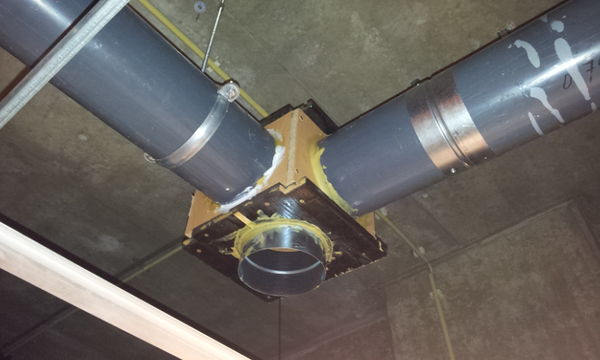
What hackerish uglyness^Wepicness actually hides above those ceiling tiles in some spots.
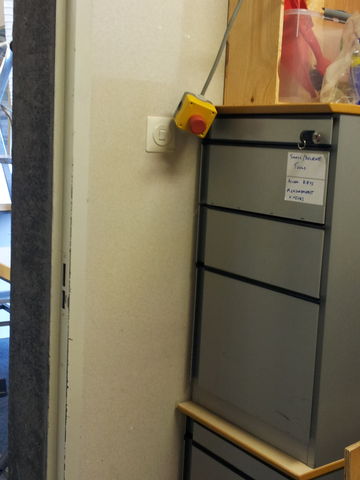
Pending a neater system, this big yellow switch is what turns it on and off now.
(*) It is fully operational. However, what it lacks at this point is the timer + overheat electronics, the kitchen inlet, the clean room inlet. These in no way inhibit its use.